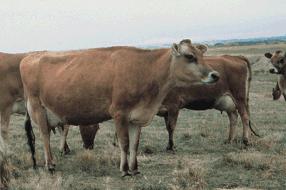| |

Anaplasmosis - The Disease
Background
- Anaplasmosis in cattle is an infectious disease of the red blood cells caused by the rickettsial bacteria Anaplasma marginale. Most commonly transmitted by ticks, A. marginale primarily causes disease in cattle. Other domestic and wild ruminants such as bison, deer, elk, sheep and goats can be infected, but clinical disease is uncommon.
- Anaplasmosis is endemic in many areas of the world including parts of the United States, while Canada experiences only sporadic cases. In June 2000, several bison in a Saskatchewan herd tested positive for the disease. Multiple outbreaks of anaplasmosis have occurred in Manitoba cattle since late 2008, the most recent report in 2013. The disease was also reported from a dairy in Ontario in 2013.
How is Anaplasmosis transmitted?
- Ticks are biological vectors of A. marginale and the disease is most commonly transmitted through infected tick bites, however mechanical transmission is also possible. In North America, ticks in the genus Dermacentor, such as the Rocky Mountain wood tick (present in Alberta) and American dog tick, are primarily responsible for spreading the bacterium. Outbreaks of anaplasmosis are usually seasonal and occur during or immediately after the tick breeding season.
- Mechanical transmission occurs by direct inoculation of cattle with blood-contaminated hypodermic needles and blood contaminated surgical or dehorning instruments. Biting flies, such as horseflies (Tabanids spp.), may also mechanically transmit the disease on their mouthparts after taking a blood meal from an infected animal.
- Wildlife may also become infected with A. marginale. While they do not show signs of disease, they may act as a reservoir for the bacteria.
Clinical signs of Anaplasmosis
- Cattle of all ages can become infected but severity of disease is age dependent with cattle less than a year old showing no or very mild clinical signs of the disease.
- Cattle between one and two years of age will develop acute clinical disease manifested by fever, going off feed, rapid shallow breathing, reluctance to walk, and pale mucous membranes but fatality is rare. Affected dairy cattle will also have a rapid decline in milk production.
- Cattle older than two years of age will also develop acute clinical disease, which may result in death prior to the observation of clinical symptoms. Fatality rates can range from 29 to 49 per cent in animals older than two years that have experienced clinical disease.
- Infected animals remain persistently infected carriers for life and are reservoirs for the organism in the herd. Current science indicates that short term treatment of infected cattle with tetracycline only temporarily eliminates the bacteria and does not eliminate the carrier state. In order to eliminate carrier state, long term treatment with tetracycline is required and this is expensive both in terms of the cost of the drug and discarded milk.
Do humans get Anaplasmosis?
Anaplasma marginale does not cause clinical disease in humans. Human anaplasmosis is caused by a related bacterium, Anaplasma phagocytophilum. A. phagocytophilum is also transmitted by bites from infected ticks. Black-legged ticks (Ixodes spp.), which are present in Alberta, are the primary vectors of A. phagocytophilum.
What can livestock producers do to reduce the risk of Anaplasmosis?
- Livestock producers play an important role in keeping their animals healthy and are encouraged to talk to their veterinarians about the disease and prevention of the disease.
- Producers must comply with all import requirements when purchasing animals from outside of Canada. This may include testing of animals for other diseases prior to import, depending on the country and location of origin.
- Once anaplasmosis is in the herd, it is costly to treat and difficult to control. Eliminating the disease generally involves identifying infected animals, using antibody testing, and culling them from the herd.
What countries have Anaplasmosis?
The disease is common in tropical and sub-tropical regions of the world. The disease is present on all six inhabited continents, especially in countries with warmer climates, including many southern states of United States, Australia, central and south America, Africa and southern Asia. Infection with A. marginale occurs only occasionally in temperate climate areas.
Producers are encouraged to monitor their animals for signs of disease and to contact their veterinarians if they suspect their animals may be infected.
Changes to Federal Anaplasmosis Program
- Effective April 1, 2014 anaplasmosis is no longer a federally reportable disease and is now listed as immediately notifiable disease. This change will mean that:
- only laboratories will be required to report suspected or confirmed cases to the Canadian Food Inspection Agency (CFIA)
- the CFIA will no longer respond to anaplasmosis cases detected on farms
- the CFIA will no longer conduct surveillance for anaplasmosis to verify Canada’s status for the disease
- Cattle, bison and elk producers in Alberta will work with their herd veterinarian to deal with cases of anaplasmosis.
- Anaplasmosis in cattle, bison, cervids, sheep and goats is a provincially notifiable disease and any suspected or confirmed cases of anaplasmosis must be reported within 24 hours to the Office of the Chief Provincial Veterinarian at 780-427-3448 during office hours or at 1-800-524-0051 after hours.
- Although the disease is provincially notifiable, Alberta Agriculture and Rural Development will not be engaging in testing and control of the disease in the province. Producers will be responsible for prevention, testing and treatment of the disease on the farm.
|
|